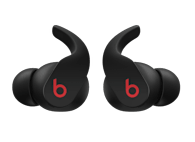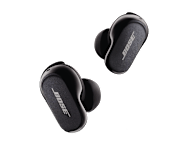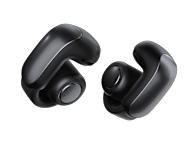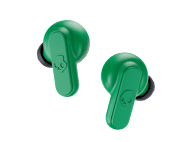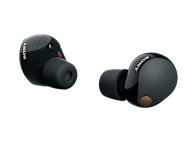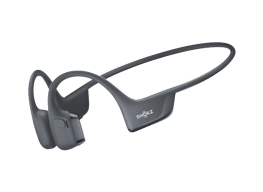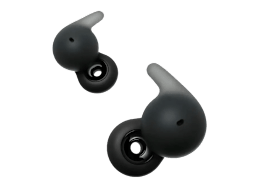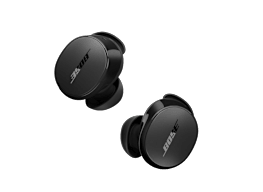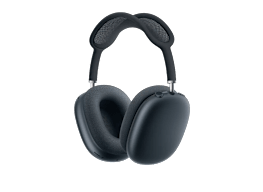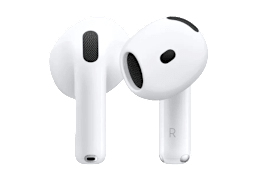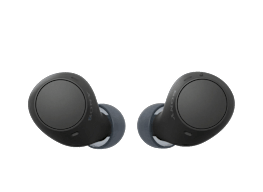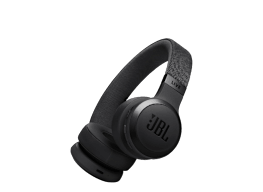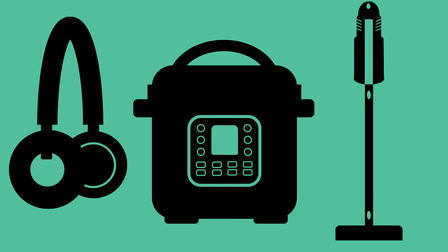Best Workout Earbuds of 2024
These wireless models from Apple, Bose, Sony, and others stay in place and deliver great sound quality
When you shop through retailer links on our site, we may earn affiliate commissions. 100% of the fees we collect are used to support our nonprofit mission. Learn more.
If you want to get in shape, a pair of great workout headphones can be a great partner. As long as they’re truly up to the task.
That’s why Consumer Reports’ testers review every model in our labs not only for sound quality but also for fit, determining whether an earbud will stay in place during vigorous head movement and whether incidental contact could cause it to pause, skip, or come loose.
Many of today’s top earbuds also have noise-canceling capability, which can reduce the ambient noise at your gym so that you can stream your tunes in peace. If you’re out running, though, a background that’s too quiet can pose a problem, canceling the sounds of traffic. So the noise-canceling models in this roundup have an ambient or transparency mode that pipes in some outside sound.
We’ve also included two models with designs that allow you to hear background noise without resorting to electronic trickery.
The workout headphones listed below get high marks in Consumer Reports’ tests on criteria including sound quality, features, comfort, and fit. They’re also advertised as water-resistant to some degree (CR doesn’t test that feature), so you can sweat without fretting. If you’re a Consumer Reports member, you can browse through more than 200 models in our headphone ratings.
It’s easy to recommend the AirPods Pro for exercise. They come with silicone ear tips in four sizes, including a tiny XS. And fitwise, our testers find that they stay stable in ears of all sizes. They have superb noise cancellation with a really effective transparency mode that pipes in outside sound to allow you to hear what’s going on around you, great if you’re out for a run on a crowded trail or a road with traffic.
The current model also has a unique suite of features, available via a free software update, that can turn the noise-canceling earbuds into over-the-counter hearing aids.
The first step is a clinical-level hearing test that takes about 5 minutes to assess your hearing. If you have hearing loss, the app tweaks the volume at various frequencies to make it easier to hear content like music and podcasts, as well as conversation. Finally, there’s an app that provides hearing protection when you’re in a noisy environment like a concert hall or a shop with power tools. We had a colleague with hearing loss evaluate the AirPods (and compare them with her expensive custom hearing aids), and overall she was impressed with their performance. If you don’t like the hearing aid functionality, it’s easy enough to turn off.
The Beats Fit Pro are high-performing wireless noise-canceling earbuds with soft silicone ear tips in three sizes, plus wingtips that fit into the pinna (the exterior of your ear) for additional security. It’s a nice alternative to the potentially clumsy wraparound clip employed by models like the Beats Powerbeats Pro.
I find the fit to be rock-solid, but you may have to take the model for a trial run to make sure it hugs your ears, too. While the Fit Pros held firm for all who reviewed them in our labs, the testers note that those with smaller ears may feel like the buds could come loose.
Controlwise, the Fit Pros have actual buttons rather than the touch-sensitive stems on AirPods. I prefer the positive click of a button, especially when using a function like track forward that requires multiple clicks. On the other hand, hitting a button on the side of the earbud did tend to push it deeper into my ear canal. The Fit Pros also sound really good and feature effective active noise cancellation, making them an alternative to the similarly priced AirPods Pro.
If you love your gym but hate the music it plays, the updated Bose QuietComfort Earbuds II may be just what you’re looking for. These true wireless earbuds get top marks for noise cancellation, which you can turn up or down to suit your environment. They also deliver very solid sound quality, though they fall a bit short of the best-sounding noise-canceling earbuds, like the Sony WF1000XM5 below.
The model earns a place in this roundup in part because it has silicone wings—Bose calls them stability bands—that help secure the earbuds when you’re exercising. Because the bands aren’t part of the ear tips, you can mix and match them, pairing medium bands with a large ear tip, for example, to fine-tune the fit.
The ear tips don’t sit as far in the ear canal as those on other models, which some people may view as an advantage. Testers with small ears find these to be a little bulky, and all note that touching the earbud’s body could inadvertently activate the controls or even knock the earbud out of an ear.
Appealing features include flexible sound equalization and built-in tech that the company says makes it easier to hear your own voice during phone calls. Bose advertises a 6-hour battery life (we don’t test that), and the case can recharge the headphones twice on the go.
If you just don’t like the feel of earbuds in your ears, consider these Bose Ultra Open buds. They’re essentially tiny speakers that sit near your ear canal like a cuff-style earring. They allow you to listen to music or podcasts without isolating you from the things happening around you.
Our testers find that the Ultra Opens sound really good. They’re also secure for most users, though larger-eared testers did have a slightly harder time getting an optimal fit and, with this design, proper positioning is important. Understand that the Boses don’t have active or passive noise cancellation, so they’re not ideal on a train, a plane, or even in a noisy office when you want to block out the world a little. But that caveat aside, they do offer a unique ability to switch seamlessly between your content and the real world.
The Sennheiser CX150 BT doesn’t need a cable to link to your phone but does have one that tethers the earbuds together and that can come in handy when you’re out cycling. If an earpiece jars loose while you’re on the move, it doesn’t get lost. You simply grab the cable and reinsert the bud into your ear.
Our testers report that the CX150 BT’s selection of earpieces makes it easy to achieve a good fit and stay in place pretty well. The audio quality is very good, better than you’ll find on some more expensive models. And while there aren’t a ton of extra features, the Sennheiser boasts a 10-hour battery life, more than enough to get you through a long ride.
If you’re having trouble finding true wireless earbuds that fit securely, consider the Shure Aonic 215 Gen 2. They feature substantial hooks that secure the earpieces to the outside of your ears. The bulky part of the earbuds sits behind your ear, which some users love and others, well, don’t.
The model comes with six pairs of tips—silicone and foam in three sizes—which should make it easy to get a good fit. Our testers report that it can take a bit of effort to get the Shures fitted securely, but once they’re on, they stay that way, even during the most vigorous exercise. They note that some users might find that using the controls can cause the bulky part of the earbuds to poke into the bone behind the ear.
And while the model doesn’t have active noise cancellation, the ear tips seal well enough to offer a substantial degree of passive isolation, which makes the ambient sound monitoring feature most welcome. Sonically, the Shures are solid performers, with a bassy sound signature that can be adjusted through flexible tone controls.
The Skullcandy Dime 2 true wireless earbuds are an absolute steal at under $30. The sound quality isn’t outstanding, but it’s above average—and very impressive, given the price.
Our testers find that the Dime 2’s fit might not be quite as secure as what you’ll experience on the very best earbuds, but the price is low enough that it’s easier to replace these earbuds if you lose one. The Dime has an advertised 3.5-hour battery life and a carrying/charging case good for an additional 8.5 hours of power.
The only difference between the Dime 2 and the original Dime is that the newer model has Bluetooth 5.2, which might make for slightly smoother connections. The new model also has a “find me” feature that can help locate missing earbuds when used with the Tile app.
If you’re exercising in a quiet environment, why not enhance your experience with the very best sound you can get? That’s where the Sony WF-1000XM5 comes in. These true wireless noise-canceling earbuds sound simply fantastic and are one of the very few models that achieve our top rating for sound quality.
The XM5s replace the highly rated XM4s, and our testers report there are some improvements. The newer earbuds are sleeker and lighter and may provide a better fit for many users, although those with smaller ears may still find them a bit bulky. Sony’s foamlike ear tips feel a bit like drugstore earplugs, but in our tests they stayed in place, even though they lack silicone wings or other fit aids like some of the models in this roundup.
Our lab testing reveals that the WF-1000XM5s sound just a little better than the XM4s with a tiny bit less distortion. They also offer top-notch noise cancellation with an effective ambient mode that allows you to hear what’s going on around you, which makes them a solid choice for walkers and runners.
If you like the idea of true wireless earbuds but you’re not a big fan of earplug-type tips sitting in your ear canal, this uniquely designed Sony model is worth a look.
The LinkBuds have a doughnut-like hole in the middle of the earbud that lets you feel connected to sound from the outside world in a way that’s not quite possible with even the best transparency mode. That makes them great for outdoor exercise or any activity where you want to maintain a connection to your surroundings, and positions them as a less-expensive alternative to the Bose Open Ultra.
There is a trade-off, however: The lack of isolation makes the LinkBuds less than great for noisy environments.
The LinkBuds stay in place, thanks to the flexible silicone ear-bowl supports—five options are included, so you can fine-tune the fit. Our testers warn that the position that’s the most secure doesn’t always deliver the best sound quality. (They report that the sound remains very satisfying, though.) With this in mind, consider purchasing the model from a retailer that offers a flexible return policy.
One other unique feature: You can control the LinkBuds by tapping on your head near your ears rather than touching the buds themselves.
Note that the similarly priced and similarly named Sony LinkBuds S use a more conventional design, with a silicone tip and active noise cancellation with an electronic ambient mode.


















